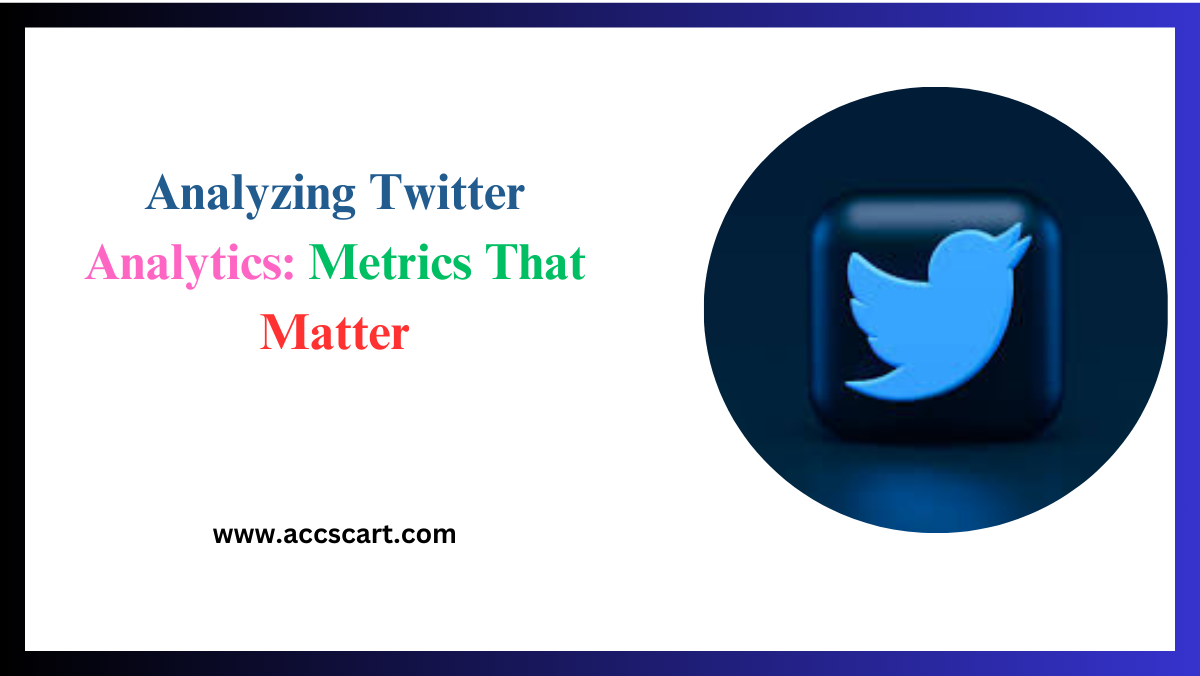In today’s digital age, Twitter remains a powerful platform for businesses to engage with their audience. But how do you know if your efforts are paying off? Understanding and interpreting Twitter analytics can help you measure the effectiveness of your campaigns. This blog post will guide you through the essential metrics, how to interpret them, and how to adjust your strategy for optimum performance.
Introduction to Twitter Analytics Tools
With millions of tweets sent every day, Twitter Analytics tools are indispensable for businesses. These tools help track the performance of tweets, understand audience behavior, and provide actionable insights. Businesses often consider whether to buy Twitter accounts or purchase Twitter accounts to boost their online presence. However, without proper analytics, these actions may not yield the desired outcomes. This section will introduce you to Twitter Analytics and why it is crucial for your social media strategy.
- Why Use Twitter Analytics?
Twitter Analytics allows you to measure the impact of your tweets and campaigns. It provides data on impressions, engagements, and audience demographics. Understanding these metrics helps you refine your content strategy, ensuring your tweets resonate with your target audience. Additionally, performance tracking through analytics can help you identify trends and adjust your strategy accordingly.
- Getting Started with Twitter Analytics
To access Twitter Analytics, log in to your Twitter account and click on the “More” option in the left-hand menu. From there, select “Analytics.” You’ll be taken to the dashboard, where you can explore various metrics and insights. Familiarize yourself with the interface and the different data points available.
- Popular Twitter Analytics Tools
While Twitter’s built-in analytics tool is robust, several third-party tools offer additional features. Tools like Hootsuite, Sprout Social, and Buffer provide more in-depth analysis and reporting capabilities. These tools can help you monitor multiple accounts, schedule tweets, and track performance over time.
Key Metrics to Monitor
Understanding which metrics to monitor is crucial for evaluating the success of your Twitter campaigns. This section will highlight the key metrics you should focus on and why they matter.
- Impressions
Impressions refer to the number of times your tweet appears in users’ timelines. High impressions indicate that your tweet has a broad reach. Monitoring impressions helps you understand how well your content is performing in terms of visibility. Aim to increase impressions by creating engaging and shareable content.
- Engagements
Engagements include likes, retweets, replies, and clicks on your tweet. High engagement rates signify that your audience finds your content interesting and valuable. Tracking engagements helps you gauge the effectiveness of your tweets and identify the type of content that resonates with your audience.
- Engagement Rate
The engagement rate is the ratio of engagements to impressions. It provides a clearer picture of how engaging your content is relative to its reach. A high engagement rate indicates that your content is not only visible but also engaging. Aim to maintain a consistent engagement rate across your tweets.

Interpreting Data Results
Interpreting the data from Twitter Analytics is essential for making informed decisions. This section will guide you on how to analyze the metrics and derive meaningful insights.
- Analyzing Trends
Look for patterns and trends in your data. Identify which tweets receive the most impressions and engagements. Analyze the timing, format, and content of these tweets to understand what works best for your audience. Use this information to refine your content strategy and create more impactful tweets.
- Understanding Audience Demographics
Twitter Analytics provides insights into your audience’s demographics, including age, gender, location, and interests. Understanding your audience helps you tailor your content to their preferences. For example, if most of your audience is interested in technology, create content that aligns with their interests.
- Measuring Campaign Performance
Use the data to evaluate the performance of your campaigns. Compare the metrics before, during, and after the campaign to assess its impact. Identify which elements contributed to the success of the campaign and which areas need improvement. This analysis will help you optimize future campaigns for better results.
Adjusting Strategy Based on Analytics
Based on the insights gained from Twitter Analytics, you can adjust your strategy to improve performance. This section will provide practical tips on how to make data-driven decisions.
- Optimizing Content Strategy
Use the data to identify the type of content that performs best. Focus on creating more of this content while experimenting with new formats and ideas. Continuously monitor the performance and adjust your strategy accordingly. Aim to keep your content fresh and engaging.
- Timing and Frequency
Analyze the timing and frequency of your tweets to determine the optimal posting schedule. Identify the times when your audience is most active and schedule your tweets accordingly. Avoid overposting, as it can lead to audience fatigue. Instead, focus on quality over quantity.
- Experimenting with New Ideas
Don’t be afraid to experiment with new ideas based on the insights gained from analytics. Try different formats, topics, and approaches to see what works best. Monitor the performance of these experiments and use the data to refine your strategy. Continuous improvement is key to success.
Case Studies of Successful Campaigns
Learning from successful campaigns can provide valuable insights and inspiration. This section will highlight a few case studies of businesses that have effectively used Twitter Analytics to achieve their goals.
1. Case Study 1: A Tech Startup
A tech startup used Twitter Analytics to identify the type of content that resonated with their audience. By focusing on educational and informative tweets, they increased their engagement rate by 30%. They also experimented with different formats, such as infographics and videos, to keep their content diverse and engaging.
2. Case Study 2: An E-commerce Business
An e-commerce business leveraged Twitter Analytics to optimize their posting schedule. By identifying the times when their audience was most active, they increased their impressions by 40%. They also used the demographic data to create targeted campaigns, resulting in a 25% increase in conversions.
3. Case Study 3: A Non-profit Organization
A non-profit organization used Twitter Analytics to measure the impact of their awareness campaigns. By analyzing the engagement rate and reach, they identified the most effective messaging and visuals. They also used the insights to tailor their content to different audience segments, resulting in a 50% increase in donations.
Lessons Learned from Case Studies
These case studies illustrate the power of leveraging Twitter Analytics to fine-tune social media strategies and achieve measurable success. A common theme across successful campaigns is the importance of understanding audience dynamics and preferences.
The tech startup showcased the value of catering content to what drives engagement, be it through educational material or visually appealing formats like infographics. Meanwhile, the e-commerce business highlighted the significance of optimized timing and how aligning posts with user activity can significantly enhance visibility and conversions.
The non-profit organization emphasized the impact of targeted messaging, demonstrating that tailoring content for different audience segments can dramatically increase campaign outcomes, such as donations. These lessons underline the importance of continuous analysis and adaptation, as ongoing monitoring and strategic adjustments lead to sustainable growth and success on social media platforms.
Future Trends in Social Media Analytics
As social media continues to evolve, so does the landscape of analytics. One emerging trend is the integration of artificial intelligence (AI) and machine learning technologies to gain deeper insights and predict future audience behavior.
These technologies can help identify trending topics, optimize content suggestions, and offer personalized user experiences. Another trend is the emphasis on video content, with platforms increasingly prioritizing video analytics to help creators understand viewer engagement and retention. Moreover, privacy concerns are leading to a shift towards more transparent data collection practices, ensuring users feel secure when engaging with brands online.
By staying informed about these trends, businesses can harness the power of the latest analytical tools and techniques to stay ahead in the competitive world of social media.
Conclusion
Mastering Twitter Analytics is essential for businesses looking to optimize their social media strategy. By understanding and interpreting the key metrics, you can make data-driven decisions that enhance your campaigns’ effectiveness. Use the insights gained from analytics to adjust your strategy, experiment with new ideas, and continuously improve your performance. Remember, successful campaigns are built on a foundation of data and insights.
Ready to take your Twitter strategy to the next level? Start leveraging Twitter Analytics today and see the difference it can make. Whether you’re looking to buy Twitter accounts, purchase Twitter accounts, or simply improve your performance tracking, understanding your analytics is key to achieving your goals.









